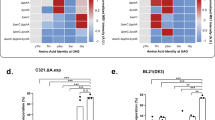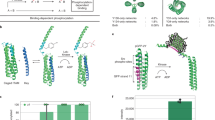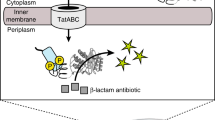Abstract
Access to phosphoproteins with stoichiometric and site-specific phosphorylation status is key to understanding the role of protein phosphorylation. Here we report an efficient method to generate pure, active phosphotyrosine-containing proteins by genetically encoding a stable phosphotyrosine analog that is convertible to native phosphotyrosine. We demonstrate its general compatibility with proteins of various sizes, phosphotyrosine sites and functions, and reveal a possible role of tyrosine phosphorylation in negative regulation of ubiquitination.
This is a preview of subscription content, access via your institution
Access options
Access Nature and 54 other Nature Portfolio journals
Get Nature+, our best-value online-access subscription
$29.99 / 30 days
cancel any time
Subscribe to this journal
Receive 12 print issues and online access
$259.00 per year
only $21.58 per issue
Buy this article
- Purchase on Springer Link
- Instant access to full article PDF
Prices may be subject to local taxes which are calculated during checkout


Similar content being viewed by others
References
Hunter, T. Curr. Opin. Cell Biol. 21, 140–146 (2009).
Tarrant, M.K. & Cole, P.A. Annu. Rev. Biochem. 78, 797–825 (2009).
Lim, W.A. & Pawson, T. Cell 142, 661–667 (2010).
Julien, S.G., Dubé, N., Hardy, S. & Tremblay, M.L. Nat. Rev. Cancer 11, 35–49 (2011).
Blume-Jensen, P. & Hunter, T. Nature 411, 355–365 (2001).
Tan, C.S. et al. Sci. Signal. 2, ra39 (2009).
Humphrey, S.J., James, D.E. & Mann, M. Trends Endocrinol. Metab. 26, 676–687 (2015).
Hornbeck, P.V. et al. Nucleic Acids Res. 40, D261–D270 (2012).
Ottesen, J.J., Huse, M., Sekedat, M.D. & Muir, T.W. Biochemistry 43, 5698–5706 (2004).
Oza, J.P. et al. Nat. Commun. 6, 8168 (2015).
Jbara, M., Maity, S.K., Morgan, M., Wolberger, C. & Brik, A. Angew. Chem. Int. Edn. Engl. 55, 4972–4976 (2016).
Serwa, R. et al. Angew. Chem. Int. Edn. Engl. 48, 8234–8239 (2009).
Chen, Z. & Cole, P.A. Curr. Opin. Chem. Biol. 28, 115–122 (2015).
Wang, L., Brock, A., Herberich, B. & Schultz, P.G. Science 292, 498–500 (2001).
Xie, J., Supekova, L. & Schultz, P.G. ACS Chem. Biol. 2, 474–478 (2007).
Park, H.S. et al. Science 333, 1151–1154 (2011).
Pirman, N.L. et al. Nat. Commun. 6, 8130 (2015).
George, S. et al. FEBS Lett. 590, 1530–1542 (2016).
Fan, C., Ip, K. & Söll, D. FEBS Lett. 590, 3040–3047 (2016).
Rogerson, D.T. et al. Nat. Chem. Biol. 11, 496–503 (2015).
Chao, H.-G. et al. J. Org. Chem. 60, 7710–7711 (1995).
Takimoto, J.K., Dellas, N., Noel, J.P. & Wang, L. ACS Chem. Biol. 6, 733–743 (2011).
Hoppmann, C. et al. Angew. Chem. Int. Edn. Engl. 53, 3932–3936 (2014).
Lacey, V.K., Louie, G.V., Noel, J.P. & Wang, L. ChemBioChem 14, 2100–2105 (2013).
Yau, R. & Rape, M. Nat. Cell Biol. 18, 579–586 (2016).
Wauer, T. et al. EMBO J. 34, 307–325 (2015).
Chong, R.A. et al. Proc. Natl. Acad. Sci. USA 111, 8434–8439 (2014).
Johnson, D.B. et al. Nat. Chem. Biol. 7, 779–786 (2011).
Xiang, Z. et al. Nat. Methods 10, 885–888 (2013).
Santoro, S.W., Wang, L., Herberich, B., King, D.S. & Schultz, P.G. Nat. Biotechnol. 20, 1044–1048 (2002).
Acknowledgements
We thank M. Kelly (UCSF NMR Core) for help with NMR measurements and helpful discussions. L.W. acknowledges the support of the NIH (R01GM118384).
Author information
Authors and Affiliations
Contributions
C.H. conducted experiments and characterized data; A.W. assigned data for NMR; B.Y. prepared UBE2D3; S.L., T.H., and K.M.S. provided helpful discussions; L.W. conceived and directed the project; and C.H. and L.W. wrote the manuscript with inputs from S.L., T.H., and K.M.S.
Corresponding author
Ethics declarations
Competing interests
The authors declare no competing financial interests.
Supplementary information
Supplementary Text and Figures
Supplementary Results, Supplementary Table 1, Supplementary Figures 1–12 and Supplementary Note 2 (PDF 2942 kb)
Supplementary Note 1
Synthesis and characterization of Uaa 1 including experimental procedure, NMR and MS spectra. (PDF 267 kb)
Rights and permissions
About this article
Cite this article
Hoppmann, C., Wong, A., Yang, B. et al. Site-specific incorporation of phosphotyrosine using an expanded genetic code. Nat Chem Biol 13, 842–844 (2017). https://doi.org/10.1038/nchembio.2406
Received:
Accepted:
Published:
Issue Date:
DOI: https://doi.org/10.1038/nchembio.2406
This article is cited by
-
Essential factors, advanced strategies, challenges, and approaches involved for efficient expression of recombinant proteins in Escherichia coli
Archives of Microbiology (2024)
-
Strategies for efficient production of recombinant proteins in Escherichia coli: alleviating the host burden and enhancing protein activity
Microbial Cell Factories (2022)
-
Enhanced access to the human phosphoproteome with genetically encoded phosphothreonine
Nature Communications (2022)
-
Therapeutic peptides: current applications and future directions
Signal Transduction and Targeted Therapy (2022)
-
Halogenation of tyrosine perturbs large-scale protein self-organization
Nature Communications (2022)



